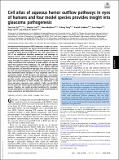Notice
This is not the latest version of this item. The latest version can be found at:https://dspace.mit.edu/handle/1721.1/136004.2
Cell atlas of aqueous humor outflow pathways in eyes of humans and four model species provides insight into glaucoma pathogenesis
| dc.contributor.author | van Zyl, Tavé | |
| dc.contributor.author | Yan, Wenjun | |
| dc.contributor.author | McAdams, Alexi | |
| dc.contributor.author | Peng, Yi-Rong | |
| dc.contributor.author | Shekhar, Karthik | |
| dc.contributor.author | Regev, Aviv | |
| dc.contributor.author | Juric, Dejan | |
| dc.contributor.author | Sanes, Joshua R | |
| dc.date.accessioned | 2021-10-27T20:30:19Z | |
| dc.date.available | 2021-10-27T20:30:19Z | |
| dc.date.issued | 2020 | |
| dc.identifier.uri | https://hdl.handle.net/1721.1/136004 | |
| dc.description.abstract | © 2020 National Academy of Sciences. All rights reserved. Increased intraocular pressure (IOP) represents a major risk factor for glaucoma, a prevalent eye disease characterized by death of retinal ganglion cells; lowering IOP is the only proven treatment strategy to delay disease progression. The main determinant of IOP is the equilibrium between production and drainage of aqueous humor, with compromised drainage generally viewed as the primary contributor to dangerous IOP elevations. Drainage occurs through two pathways in the anterior segment of the eye called conventional and uveoscleral. To gain insights into the cell types that comprise these pathways, we used high-throughput single-cell RNA sequencing (scRNAseq). From ∼24,000 single-cell transcriptomes, we identified 19 cell types with molecular markers for each and used histological methods to localize each type. We then performed similar analyses on four organisms used for experimental studies of IOP dynamics and glaucoma: cynomolgus macaque (Macaca fascicularis), rhesus macaque (Macaca mulatta), pig (Sus scrofa), and mouse (Mus musculus). Many human cell types had counterparts in these models, but differences in cell types and gene expression were evident. Finally, we identified the cell types that express genes implicated in glaucoma in all five species. Together, our results provide foundations for investigating the pathogenesis of glaucoma and for using model systems to assess mechanisms and potential interventions. | |
| dc.language.iso | en | |
| dc.publisher | Proceedings of the National Academy of Sciences | |
| dc.relation.isversionof | 10.1073/PNAS.2001250117 | |
| dc.rights | Article is made available in accordance with the publisher's policy and may be subject to US copyright law. Please refer to the publisher's site for terms of use. | |
| dc.source | PNAS | |
| dc.title | Cell atlas of aqueous humor outflow pathways in eyes of humans and four model species provides insight into glaucoma pathogenesis | |
| dc.type | Article | |
| dc.relation.journal | Proceedings of the National Academy of Sciences of the United States of America | |
| dc.eprint.version | Final published version | |
| dc.type.uri | http://purl.org/eprint/type/JournalArticle | |
| eprint.status | http://purl.org/eprint/status/PeerReviewed | |
| dc.date.updated | 2021-07-22T16:39:04Z | |
| dspace.orderedauthors | van Zyl, T; Yan, W; McAdams, A; Peng, Y-R; Shekhar, K; Regev, A; Juric, D; Sanes, JR | |
| dspace.date.submission | 2021-07-22T16:39:06Z | |
| mit.journal.volume | 117 | |
| mit.journal.issue | 19 | |
| mit.license | PUBLISHER_POLICY | |
| mit.metadata.status | Authority Work and Publication Information Needed |
